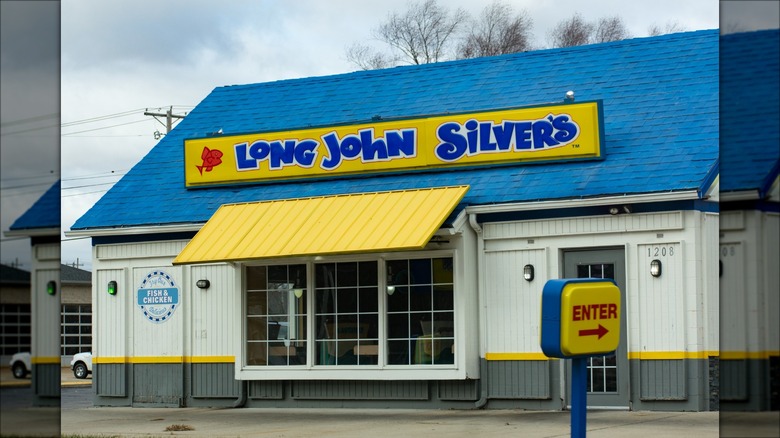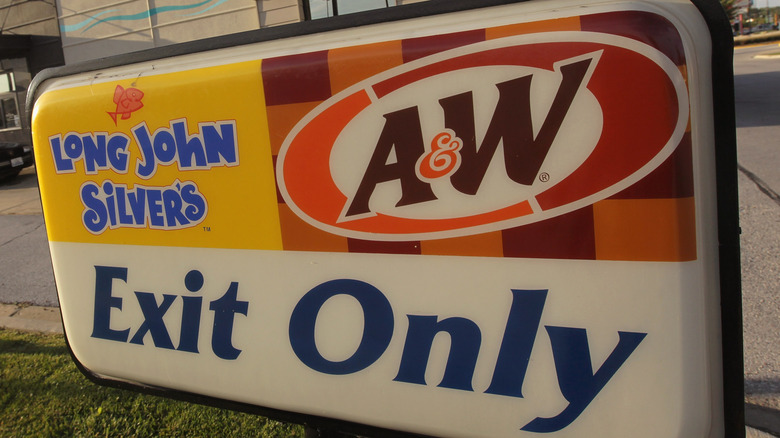Why Long John Silver's Almost Didn't Survive Through Y2K
The turn of the 20th century was a strange time for our society. The biggest reason? The entire world was gripped by the fear of a cataclysmic event dubbed Y2K. According to Forbes, the belief at the time was that computers would be unable to comprehend the transition from the year 1999 to the year 2000, mainly because they had been programmed to interpret years only by their last two digits. Many feared that computers would read '00' as the year 1900, and systems across the globe would collapse. Newspapers, magazines, and even books predicted a complete ruination of civilization. Evangelical Pastor Jerry Falwell suggested the event was destined to shake the nation in advance of the Rapture, per Forbes.
Suffice it to say, none of that happened. It turns out that people just didn't understand computers very well, save for select IT workers who made key improvements to computer systems so they could avoid the problem. But there was one brand for whom the turn of the millennium proved to be catastrophic indeed — though not for the reasons the rest of the world was so concerned about. According to Mental Floss, Long John Silver's, the once mighty over-the-counter seafood force, was driven into bankruptcy, and ultimately escaped the 20th century by the skin of its teeth. The saga involved numerous financial missteps, an angry group of cops, and, bizarrely, the sci-fi franchise "Lost in Space."
A sinking ship
Many people would rightfully be skeptical of a seafood restaurant based in landlocked Kentucky, but the improbable force that is Long John Silver's grew from its roots in the Bluegrass State to become the largest seafood restaurant chain in the United States. At its peak between 1970 and 1979, the company boasted more than 1,000 locations across the country, according to the Long John Silver's website. Per Mental Floss, the decline began when, in the late 1980s, rising fish prices and increased competition from other fast food businesses took a heavy toll on the pirate-themed brand. In 1989, when the company took its business private, it landed in the hands of an investment group that paid $620 million for the honor.
According to a 1998 report from the Gadsden Times, the new ownership group proved disastrous for Long John Silver's, racking up a significant amount of debt and instigating company-wide layoffs. In the late 90s, they faced a trifecta of controversy. First off, the Fraternal Order of Police began protests against the chain due to an advertising campaign that featured a cop stealing civilians' food. Then Long John Silver's was sued by a company alleging they stole their slogan, "grab and go." Finally, in 1998, the company was again sued for failing to pay the $3 million they owed for promotional toys based on the science fiction series "Lost in Space."
Escaping bankruptcy (barely)
Long John Silver's faced its darkest day in June 1998, when the Gadsden Times reported the once-dominant fast food chain filed for Chapter 11 bankruptcy. With assets just over $329 million, Long John Silver's found itself saddled with liabilities of $457.3 million, leaving ownership with little choice but to head to bankruptcy court. Salvation came in 1999, when, according to Mental Floss, Long John Silver's was purchased by A&W Restaurants — but while the seafood chain was safe from choppy waters, for the time being, another storm was just on the horizon. Ownership was destined to change hands again in 2002 when QSR magazine reported that both Long John Silver's and A&W had been sold to Tricon Global Restaurants, the powerhouse group behind KFC and Taco Bell. Less than 10 years later, the brand was again sold to franchisees.
Bad press continued to dog the business well into the 21st century. In 2013, the Center for Science in the Public Interest declared that Long John Silver's Big Catch — a fully fried meal consisting of fish, hushpuppies, and onion rings that reportedly contained 33 grams of trans fat – was the "Worst Restaurant Meal in America." Discontinuing this meal did nothing to curb the steady decline of the business. At the peak of its power, Long John Silver's had more than 1,000 locations, but in 2022, the company reported that the number had been cut to less than 700 (via PR Newswire).


